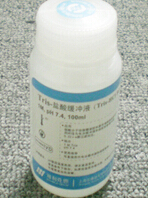
Capsaicin辣椒素
货 号:ab141000
产品规格:100 mg
原 产 地:abcam
参考价格:1077 (参考价格,以实际价格为准)
优惠价格:
Capsaicin ab141000 100 mg abcam
- Product name(E)-Capsaicin
- Description
Vanilloid receptor (VR1) agonist
- Biological descriptionVanilloid receptor (VR1) agonist (pEC50 values are 7.5 and 6.1 at human and rat VR1 receptors respectively). Antinociceptive and anti-inflammatory effects mediated by primary afferent sensory neurones. Induces reversible inhibition of platelet aggregation.
- Purity> 98%
Properties
- Chemical name(6E)-N-[(4-Hydroxy-3-methoxyphenyl)methyl]-8-methyl-6-nonenamide
- Molecular Weight305.42
- Chemical structure

- Molecular formulaC18H27NO3
- CAS Number404-86-4
- PubChem identifier2548
- Storage instructionsStore at +4°C.
- Solubility overviewSoluble in DMSO to 50 mM and in ethanol to 50 mM
- Handling
Providing storage is as stated on the product vial and the vial is kept tightly sealed, the product can be stored for up to 12 months.
Wherever possible, you should prepare and use solutions on the same day. However, if you need to make up stock solutions in advance, we recommend that you store the solution as aliquots in tightly sealed vials at -20°C. Generally, these will be useable for up to one month. Before use, and prior to opening the vial we recommend that you allow your product to equilibrate to room temperature for at least 1 hour.
- SMILESOc1ccc(cc1OC)CNC(=O)CCCC/C=C/C(C)C
- Source
Capsicum sp.
同类产品SIGMA品牌
Capsaicin≥95%, from Capsicum sp. (Sigma)
M2028-50MG 777元/50mg
- Tache Y Brainstem neuropeptides and vagal protection of the gastric mucosal against injury: role of prostaglandins, nitric oxide and calcitonin-gene related peptide in capsaicin afferents. Curr Med Chem 19:35-42 (2012). Read more (PubMed: 22300074) »
- Caterina MJ et al. The capsaicin receptor: a heat-activated ion channel in the pain pathway. Nature 389:816-24 (1997). Read more (PubMed: 9349813) »
- Holzer P Capsaicin: cellular targets, mechanisms of action, and selectivity for thin sensory neurons. Pharmacol Rev 43:143-201 (1991). Read more (PubMed: 1852779) »
- Bevan S & Szolcsányi J Sensory neuron-specific actions of capsaicin: mechanisms and applications. Trends Pharmacol Sci 11:330-3 (1990). Read more (PubMed: 2203194) »
产品详细信息
Capsaicin ab141000 100 mg abcam
- Product name(E)-Capsaicin
- Description
Vanilloid receptor (VR1) agonist
- Biological descriptionVanilloid receptor (VR1) agonist (pEC50 values are 7.5 and 6.1 at human and rat VR1 receptors respectively). Antinociceptive and anti-inflammatory effects mediated by primary afferent sensory neurones. Induces reversible inhibition of platelet aggregation.
- Purity> 98%
Properties
- Chemical name(6E)-N-[(4-Hydroxy-3-methoxyphenyl)methyl]-8-methyl-6-nonenamide
- Molecular Weight305.42
- Chemical structure

- Molecular formulaC18H27NO3
- CAS Number404-86-4
- PubChem identifier2548
- Storage instructionsStore at +4°C.
- Solubility overviewSoluble in DMSO to 50 mM and in ethanol to 50 mM
- Handling
Providing storage is as stated on the product vial and the vial is kept tightly sealed, the product can be stored for up to 12 months.
Wherever possible, you should prepare and use solutions on the same day. However, if you need to make up stock solutions in advance, we recommend that you store the solution as aliquots in tightly sealed vials at -20°C. Generally, these will be useable for up to one month. Before use, and prior to opening the vial we recommend that you allow your product to equilibrate to room temperature for at least 1 hour.
- SMILESOc1ccc(cc1OC)CNC(=O)CCCC/C=C/C(C)C
- Source
Capsicum sp.
同类产品SIGMA品牌
Capsaicin≥95%, from Capsicum sp. (Sigma)
M2028-50MG 777元/50mg
- Tache Y Brainstem neuropeptides and vagal protection of the gastric mucosal against injury: role of prostaglandins, nitric oxide and calcitonin-gene related peptide in capsaicin afferents. Curr Med Chem 19:35-42 (2012). Read more (PubMed: 22300074) »
- Caterina MJ et al. The capsaicin receptor: a heat-activated ion channel in the pain pathway. Nature 389:816-24 (1997). Read more (PubMed: 9349813) »
- Holzer P Capsaicin: cellular targets, mechanisms of action, and selectivity for thin sensory neurons. Pharmacol Rev 43:143-201 (1991). Read more (PubMed: 1852779) »
- Bevan S & Szolcsányi J Sensory neuron-specific actions of capsaicin: mechanisms and applications. Trends Pharmacol Sci 11:330-3 (1990). Read more (PubMed: 2203194) »
